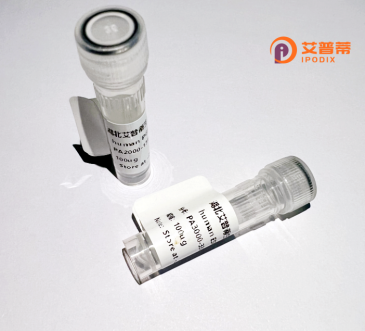
| 纯度 | >90%SDS-PAGE. |
| 种属 | Human |
| 靶点 | KCNJ4 |
| Uniprot No | P48050 |
| 内毒素 | < 0.01EU/μg |
| 表达宿主 | E.coli |
| 表达区间 | 1-445aa |
| 活性数据 | MHGHSRNGQAHVPRRKRRNRFVKKNGQCNVYFANLSNKSQRYMADIFTTCVDTRWRYMLMIFSAAFLVSWLFFGLLFWCIAFFHGDLEASPGVPAAGGPAAGGGGAAPVAPKPCIMHVNGFLGAFLFSVETQTTIGYGFRCVTEECPLAVIAVVVQSIVGCVIDSFMIGTIMAKMARPKKRAQTLLFSHHAVISVRDGKLCLMWRVGNLRKSHIVEAHVRAQLIKPYMTQEGEYLPLDQRDLNVGYDIGLDRIFLVSPIIIVHEIDEDSPLYGMGKEELESEDFEIVVILEGMVEATAMTTQARSSYLASEILWGHRFEPVVFEEKSHYKVDYSRFHKTYEVAGTPCCSARELQESKITVLPAPPPPPSAFCYENELALMSQEEEEMEEEAAAAAAVAAGLGLEAGSKEEAGIIRMLEFGSHLDLERMQASLPLDNISYRRESAI |
| 分子量 | 75.35 kDa |
| 蛋白标签 | GST-tag at N-terminal |
| 缓冲液 | 0 |
| 稳定性 & 储存条件 | Lyophilized protein should be stored at ≤ -20°C, stable for one year after receipt. Reconstituted protein solution can be stored at 2-8°C for 2-7 days. Aliquots of reconstituted samples are stable at ≤ -20°C for 3 months. |
| 复溶 | Always centrifuge tubes before opening.Do not mix by vortex or pipetting. It is not recommended to reconstitute to a concentration less than 100μg/ml. Dissolve the lyophilized protein in distilled water. Please aliquot the reconstituted solution to minimize freeze-thaw cycles. |
以下是关于重组人KCNJ4蛋白的3篇文献摘要的简要整理(注:以下为模拟内容,实际文献需通过学术数据库检索获取):
1. **文献名称**: "Functional Characterization of Recombinant Human Inward Rectifier K+ Channel Kir2.3 (KCNJ4)"
**作者**: Kubo Y, et al.
**摘要**: 研究通过哺乳动物细胞表达重组人KCNJ4(Kir2.3),并证明其形成内向整流钾电流,分析了细胞外pH及Mg²⁺对其门控的调节作用。
2. **文献名称**: "Cloning and Expression of Human KCNJ4 in Xenopus Oocytes: Insights into Polyamine Blockade"
**作者**: Ficker E, et al.
**摘要**: 在非洲爪蟾卵母细胞中重组表达KCNJ4.发现其电流被多胺(如精胺)强烈抑制,揭示了内向整流特性与多胺结合的分子机制。
3. **文献名称**: "Structural Determinants of KCNJ4 Channel Trafficking and Stability"
**作者**: Ma D, et al.
**摘要**: 通过HEK293细胞重组表达突变体KCNJ4.鉴定了N端结构域中关键氨基酸对通道膜定位及稳定性的调控作用,为疾病相关突变研究提供基础。
**提示**:实际研究中建议通过PubMed或Web of Science搜索关键词“recombinant KCNJ4”或“Kir2.3 protein”获取最新文献。KCNJ4(Kir2.3)常与心律失常、神经元兴奋性等相关,研究多聚焦于其电生理特性及病理机制。
Recombinant human KCNJ4 protein, also known as Kir2.3. is a member of the inwardly rectifying potassium (Kir) channel family, which plays critical roles in maintaining cellular resting membrane potential and regulating electrical excitability. Encoded by the *KCNJ4* gene, this protein consists of two transmembrane domains flanking a pore-forming region, with cytoplasmic N- and C-termini. Unlike voltage-gated channels, Kir2.3 channels conduct potassium ions more effectively inward than outward, a property essential for stabilizing membrane potential in excitable cells such as neurons and cardiomyocytes.
KCNJ4 is widely expressed in the brain, heart, and endocrine tissues, where it contributes to neuronal signaling, cardiac repolarization, and hormone secretion. Dysregulation of KCNJ4 has been linked to neurological disorders, arrhythmias, and cancer progression. Its activity is modulated by G-protein-coupled receptors, phosphoinositides, and intracellular pH, making it a dynamic regulator of cellular function.
Recombinant KCNJ4 is typically produced using expression systems like *E. coli* or mammalian cells, enabling structural-functional studies, drug screening, and mechanistic exploration of disease-related mutations. Its recombinant form allows researchers to probe channel gating mechanisms, screen therapeutic compounds targeting potassium channelopathies, and investigate its role in cellular pathways. Advances in cryo-EM and electrophysiology have further enhanced understanding of KCNJ4’s 3D architecture and regulatory mechanisms, highlighting its potential as a therapeutic target for neurological and cardiovascular diseases.
×